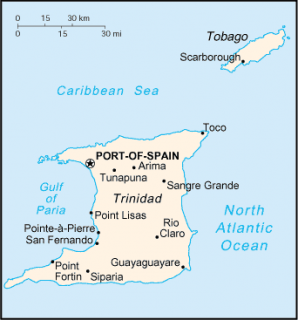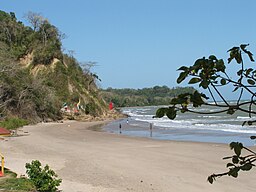
Exploring the history and experiences of mixed heritage persons and inter-racial relationships across the world

Exploring the history and experiences of mixed heritage persons and inter-racial relationships across the world
 Like Suriname, the island state of Trinidad and Tobago which includes several smaller islands is one of those countries in this region of the world that could be considered South America but due to their closer relationship in terms of culture and history are generally regarded as part of the Caribbean.
Like Suriname, the island state of Trinidad and Tobago which includes several smaller islands is one of those countries in this region of the world that could be considered South America but due to their closer relationship in terms of culture and history are generally regarded as part of the Caribbean.
Like many other West Indian islands, both Trinidad and Tobago were originally settled by Amerindians of South American origin. Trinidad was settled mainly by the Arawaks and is regarded as having been one of the earliest-settled parts of the Caribbean. Tobago on the other was settled by the Caribs whose range extends all over the southern Caribbean which is named after them. The Caribs displaced both Arawak and Taíno peoples throughout the region usually assimilating the Arawak and Taíno women and in so doing were a mixed population. It would appear that the first Europeans to visit Tobago were the English in 1580 but it was the Courlanders who settled there around 1654. This separate history is for the most part the history of the two islands until 1888/89 when the two islands were united into a British crown colony.
 Trinidad was a Spanish colony from the times of Christopher Columbus discovery to 1802 when it was became part of the British West Indies. As with other parts of the Spanish colonial empire, the early Spanish settlers enslaved but also mixed with the Amerindians resulting in a growing Mestizo population. The usual raft of old world diseases and harsh conditions imposed by the colonialists meant the indigenous Amerindians slowly faded out of existence save for a small Carib population that exists today. The Spanish began bringing African slaves to the island from as early as 1517. Miscegenation continued with a Mulatto (term used to describe a mixed European/African person) population adding to the mix on the island.
Trinidad was a Spanish colony from the times of Christopher Columbus discovery to 1802 when it was became part of the British West Indies. As with other parts of the Spanish colonial empire, the early Spanish settlers enslaved but also mixed with the Amerindians resulting in a growing Mestizo population. The usual raft of old world diseases and harsh conditions imposed by the colonialists meant the indigenous Amerindians slowly faded out of existence save for a small Carib population that exists today. The Spanish began bringing African slaves to the island from as early as 1517. Miscegenation continued with a Mulatto (term used to describe a mixed European/African person) population adding to the mix on the island.
Echoing the Haitian experience, a Frenchman obtained a concession in the form of the Spanish crown’s 1783 Cedula of Population law which promised free land to Europeans willing to relocate to Trinidad. The French, as well as many other Europeans came other parts of the Caribbean with their slaves and from Europe to work the plantations adding to an already mixed population. The concession was granted as Trinidad was under-populated and the French influx greatly influenced the island with French becoming the ‘de-facto’ language. This European mix and low population may be the reason why the Spanish Governor gave up the colony to the British without a fight in 1802. Trinidad became a British crown colony, with a French-speaking population and Spanish laws. Even under the early British rule, the island’s population grew slowly and by the time slavery was abolished there were only 18,000 or so slaves – compared to the 360,000 in Jamaica which is only twice as large as Trinidad.
Tobago changed hands over 30 times between several colonial powers including the Spanish, English, French and the Dutch until in 1814 when it became part of the British Empire. It appears to have followed a more typical West Indian history with white settlers as land owners with a larger number of slaves working on the plantation though it is said that many land-owners had less than 10 slaves at the time of emancipation.
Slavery was abolished in 1834 and as occurred throughout the region, many ex-slaves either wanted more pay or refused to work the plantations, opting instead to move to urban areas. To alleviate the resultant labour shortage the importation of indentured labour, sometimes known as the alternative slavery, commenced. The earlier influx of indentured servants came from places such as China but by the early 1840s there were also French and Creole, West African, Europeans such as Irish, German, Portuguese, Italian and Dutch and of course people from other Caribbean islands including the Irish and their descendants of the Irish slave trade. Many of these people did not leave the islands afterwards and some inter-married with the already mixed local or other foreign populations. The majority of these new arrivals went to Trinidad.
The most long ranging effect of this indenture policy started with the arrival of the East Indians to Trinidad on May 30, 1845 and this day is now celebrated as Indian Arrival Day. Up to the time the use of indentured service was abolished in 1917, more than 145,000 Indians were brought to Trinidad to work on sugarcane plantations. The Indians and other indentured labour were kept separately, and required to carry ID papers, from the ‘locals’ finally making up the highest percentage of the population in the rural areas of the island.
Throughout the 19th Century, Syrian and Lebanese communities, pre-dominantly Christian and fleeing religious persecution, formed and Spanish-speaking labourers from Venezuela commonly referred to as "Cocoa Panyols" arrived to clear forests and work in cocoa cultivation. A second wave of Chinese labour was brought about by the revolution in 1911.
Later in the mid-1900s, a second group of Indian people, generally professionals and business people and wealthier than the previous indentured labour, steadily migrated to Trinidad. These new immigrants from India were referred to as "coolies", a derogatory term used for many of them who kept their Indian customs. This aloof separation was positively encouraged by the British colonial system of separating and the racial acceptance where Indian culture was valued above African. The British colonial hierarchy resulted in the white landowner and political elite at the top, the Asian and Portuguese business sector, the skilled and semi-skilled Afro and mixed race class and the poor mainly Indian indentured labour at the bottom.
This was different in Tobago where the majority African ex-slaves formed the lower class due to the lack of indentured labour. Today, 4% of the country’s population reside on Tobago and the vast majority are Afro-Toboggans. For Trinidad, the Indian influx changed the racial dynamic of the islands as it did in parts of northern South America such as Suriname and Guyana.
Indo-Trinidadians now make up some 40% of the total 1.3 million strong population and at slightly less, the Afro-Trinidadians and the Afro-Toboggans make up over 39%. Nearly 20% of the population identify as mixed race and many of those have Indian ancestry. Those of the classic Indo-Afro admixture are known locally as Dougla (a term consider derogatory in parts of India) but there are other ethnic mixes. The rest of the population include European, Chinese, Arab and other minority groups.
Apart from the Indian aspect, the demarcation between Trinbagonian ethnicities seems to rest on some social and some visual cues and is in some flux. Whilst Afro-Trinbagonian are regarded the descendants of African slaves, this is not entirely true as it appears that not to be classified as Indo-Trinbagonians, mixed or some other ethnic identity makes you Afro-Trinbagonian. It is possible for a visually ‘white’ person to be classified ‘black’. Generally, like other parts of the Anglophone West Indies, Afro-Trinbagonians self-identity as black as opposed to the ex-Spanish colonies where the populations tend to self-classify mixed or white. To complicate matters, the term ‘creole’ (Spanish criollo) is sometimes used to encompass non-Indian individuals but is also used to describe ‘white’ Trinbagonians, not Europeans, such as the ‘French Creoles’.
Politically, there appears to be a political power division based along the Indo and Afro ethnicity lines and thankfully this rivalry between the Indo and Afro citizens has not got so intense to cause the kind of ethnic violence that was seen in Guyana between similar groups.
Mirroring other parts of the Caribbean, emigration from Trinidad and Tobago has been historically high though slowing with communities in other Caribbean nations, the United States, Canada, and Britain.
Links